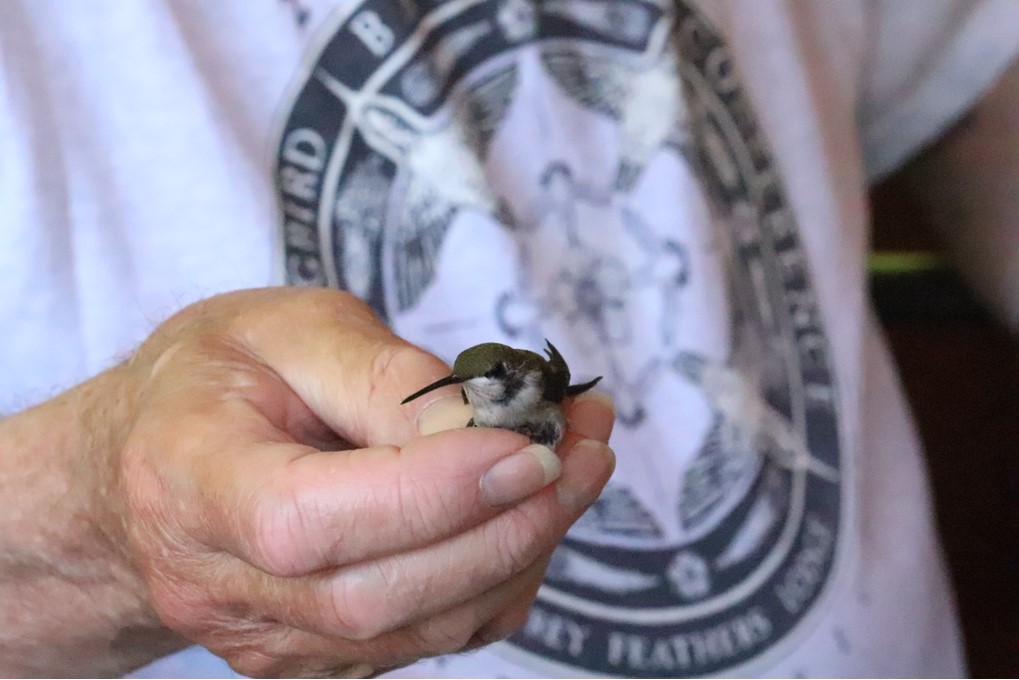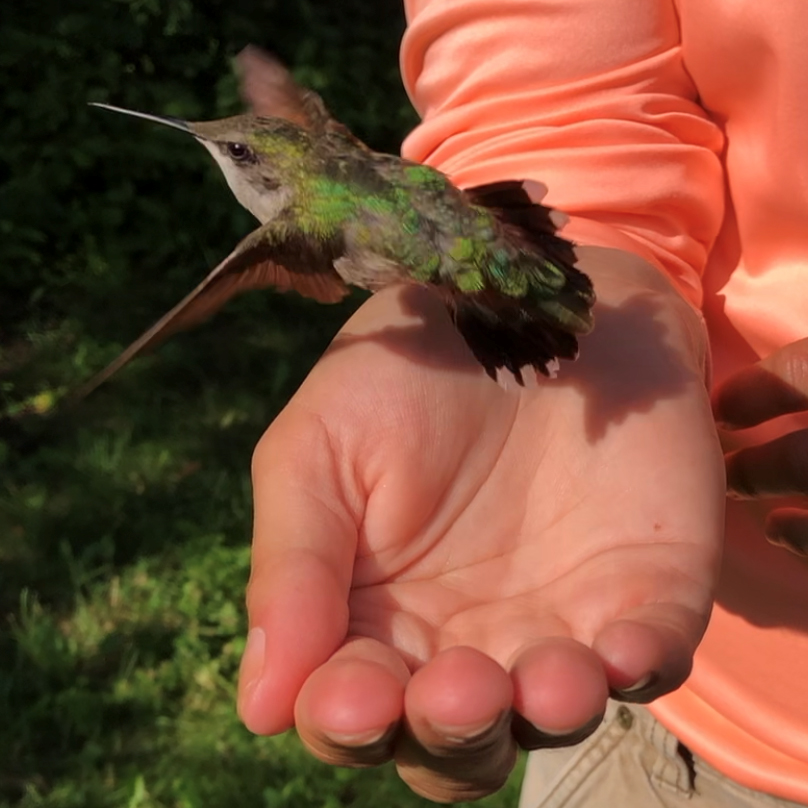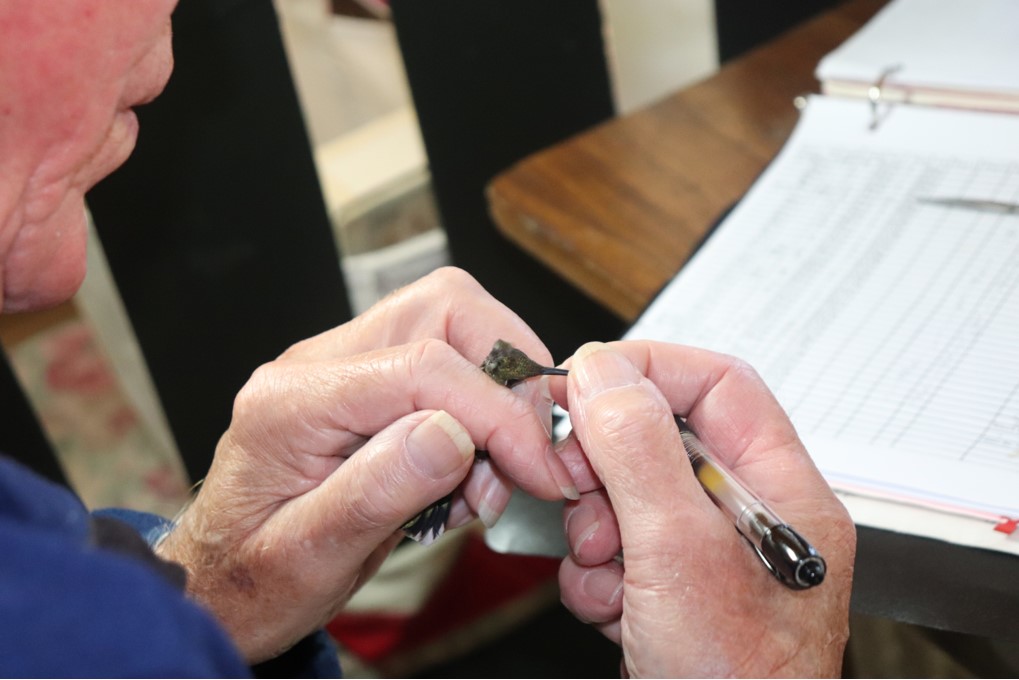In Maine, hummingbird banders track the migrating birds on their journey

Like tourists, hummingbirds love summering in Maine. Between the months of May and September, lush Maine is the ideal stopover for these migrating tropical birds on their route from South America to Canada and back again.
Bob Yunick tries to visit Maine every year from upstate New York for the hummingbirds. It didn’t start that way, though: he first came to Maine to visit a former neighbor who had moved out by Mooselookmeguntic Lake near the western border of the state. The friends planned to go fishing, but a different kind of wildlife caught Yunick’s eye.
“I noticed feeders with huge amounts of hummingbirds,” Yunick said. “The Maine lake country seems to be a preferred habitat for ruby-throated hummingbirds: the water, the woods, the climate, the whole nine yards.”
Yunick doesn’t just watch hummingbirds, though. He is one of the few people licensed to band hummingbirds for scientific research.
Bird banding is the process of marking individual birds by carefully wrapping a numbered metal or plastic tag around their ankles.
“Banding is the only way of identifying a bird as an individual,” said Anthony Hill, a councilor for the Eastern Bird Banding Association and a hummingbird bander from South Hadley, Massachusetts, who also bands hummingbirds in Maine. “We refer to it as the bird’s social security number.”

Bird banding is not a citizen science free-for-all, though. The federal government distributes permits and regulates bird banding to ensure the safety of the birds and the best possible data.
“Your responsibility as a bander is to report all the bands you put on birds back to the [United States Geological Survey’s] Bird Banding Laboratory,” Hill said. “They maintain all the records [and] put together a picture of how long these birds live. A lot of information can be gathered from that simple act.”
Because hummingbirds are small, delicate and difficult to catch, hummingbird banding is a particular skill, one that is rare even among qualified bird banders.
In Maine, hummingbird banders are not only preserving a rare and important skill, but they are also on the scientific frontlines of a strange new phenomenon that scientists can’t yet explain: vagrant Western hummingbirds winding up on Eastern shores.
The hummingbird banders of Maine
Only a few people are permitted to band hummingbirds who make their way up to Maine. Nationally, there are under 200 banders have permits to band hummingbirds, compared to thousands of master banders of other birds.
“It does take special permitting, and you have to undergo special training,” Yunick said.
The path to becoming a trained hummingbird bander isn’t always clear, either. Hill completed his hummingbird banding certification in 2004. He was introduced to hummingbird banding years earlier at one of Hog Island Audubon Camp’s natural history camp sessions. There, one of the instructors Sarah Morris, a professor at Canisius College in Buffalo, New York, who does research on songbirds and migration and has a research station on Appledore Island, took Hill under her wing and encouraged him to apply for his own hummingbird banding permit.
“It’s sort of like an old-fashioned apprenticeship program,” Hill said. “I don’t know of any academic institutions that offer banding. If someone is interested, they need to go and spend time at a banding operation and help by writing down measurements and gradually getting into it.”
The art of hummingbird banding
Hummingbird banding is as much an art as a science. Because they are so small and delicate, hummingbirds are more difficult to band than other birds.
“It’s different that you’re dealing with very small dimensions,” Yunick said. “It takes a lot of care and special expertise to handle hummingbirds and do the banding properly.”
First, banders catch the birds. Some hummingbird banders use mist nets, but Hill said prefers to use a feeder with a gentle trapdoor.
Then comes banding. Hummingbird bands are printed on thin sheets of aluminum, less than a millimeter wide and long. While you can hold other small birds by their legs, hummingbird legs and feet are too tiny to even walk, much less grasp with clumsy human fingers without hurting the birds. Hummingbird banders gently steady the bird between their fingers, using small pliers and surgical precision to wrap the band around the birds’ legs.
“You have to be careful with the way their wings are positioned,” Hill warned. “They are fragile. [You also have to] be particularly aware of watching it to make sure it’s not getting stressed. If I’m banding and I see bird is showing distress — puffing up feathers, opening and closing its beak, closing eyes — I let them go.”

Safe handling is central to hummingbird banding training. Still, hummingbird banding has its critics, particularly from people who feel the birds should not be handled by humans, even for the sake of scientific data.
“Unfortunately, [hummingbird banding] requires that somebody has bird in hand to read the band number,” Hill said. “There is some level of controversy about it.”
In light of criticism, Hill insists that hummingbird banding is done with the utmost care.
“It is our responsibility to do this carefully and within scientific reason,” Hill asserted. “All of the banders I know are supremely careful and very concerned about birds’ welfare for the few seconds or minutes you have them in your possession.”
What hummingbird banders are seeing in Maine
Hummingbird banders have noticed unusual patterns in Maine. Normally, only ruby-throated hummingbirds migrate through Maine, but more and more vagrant hummingbirds from the West Coast have traveled thousands of miles to the Pine Tree State.
On Halloween in 2008, Hill received a call from a friend at Maine Audubon who said that a strange bird was visiting a feeder in Blue Hill. He suspected it may be a Calliope hummingbird, the smallest bird in North America, which is primarily found on the West Coast and Southwestern United States.
“Having one up here on the East Coast of Maine in Blue Hill extremely unusual,” Hill said.
Hill contacted the homeowner and hurried up to Maine. The morning he caught the bird — young, male and healthy, he said — it 23 degrees Fahrenheit.
“It was very lively, very healthy,” he said. “A very small body like that it’s hard to keep warm, but their metabolism is extraordinary.”
The last he saw of the Calliope hummingbird, Hill said it was flying Southwest.
In 2012, he found another outsider: a rusty red Rufous hummingbird in Biddeford instead of its usual West Coast haunts. This was less unusual than the errant Calliope. Hill said there have been dozens of Rufous hummingbirds banded in other parts of the New England. Hundreds of Rufous hummingbirds have also been banded in Pennsylvania over the last five to ten years.
“There’s something funky going on,” Hill said. “In the last 15 or 20 years, we’ve started seeing these birds that are breeding primarily on the other side of the country and showing up [on the East Coast] in the fall and early winter. If there were one or two, we might think, ‘This is a bird with a bad set of navigation genes,’ but this has been seen consistently now.”
The presence of vagrant hummingbirds is so consistent, in fact, that scientists think it may indicate a new, rapidly-developing phenomenon in their migration patterns.
“It’s become pretty well-documented pattern of Western hummingbirds coming East in the fall,” said Doug Hitchcox, staff naturalist at Maine Audubon. “It’s kind of amazing to see such range shifts going on in such a short time period. It’s changing what is known about the species.”
Scientists and naturalists cannot yet explain the vagrant hummingbird phenomenon, though other species’ migrational shifts have been attributed to the warming climate. The data collected by hummingbird banders’ observations will be instrumental to reach scientific conclusions about wayward hummingbirds in Maine and beyond.
“The species are hard, if not impossible, to separate in the field,” Hitchcox explained. “You need to have someone have the bird in the hand taking measurements of individual tail feathers to at least figure out on a species level what we’re talking about.”
Banders and scientists agree, though, that community interest in hummingbirds is just as helpful to gathering data about the species.
“[Vagrant hummingbirds] typically show up at people’s feeders,” Hitchcox said. It’s gotten to the point now that in the fall and late September, we post messages encouraging people to keep their hummingbird feeders up later to see if any vagrants passing through. It’s amazing how often it works.”
Hitchcox bid for the public to notify Maine Audubon if they spot an unusual, tiny bird at their feeders — “If you see something, say something,” he pleaded — so scientists can continue tracking this trend.
If a vagrant hummingbird does show up at a feeder in Maine, Hill, Yunick or one of their banding compatriots will be there to record it for science, and for posterity.
